The origins of blacksmithing go back to ancient times. The first mention of blacksmiths is found in myths ancient greece: from the time when the divine blacksmith Hephaestus forged nails for the crucifixion of Prometheus on the Caucasian rock. This is where the history of blacksmithing began.
The name of Cain, the first son of Adam and Eve, etymologically means "blacksmith". Among his descendants was Tubal Cain, who chose blacksmithing. The Bible identifies him as an inventor different kind copper and iron tools used both for agriculture and for military operations. One of the first mentions of blacksmiths is in the story of the construction of the Jerusalem Temple under King Shlomo. Among those who built the walls of Jerusalem under Nehemiah were blacksmiths who made doors and gates with locks and bolts. In Jerusalem, before its capture by the Romans in 70 BC, some streets and quarters were inhabited exclusively by blacksmiths.
In Russia, iron was known to the early Slavs. Most old method metalworking is forging. At first, ancient people beat spongy iron with mallets in a cold state in order to "squeeze the juice out of it", i.e. remove impurities. Then they began to heat the metal and give it the desired shape.
Already in the 7th-9th centuries. the Slavs have special settlements of metallurgists. Forges in Slavic settlements were located away from residential buildings, near rivers: the blacksmith constantly needed fire in the forge to soften the metal and water to cool the finished products. blacksmith craft It was considered among the Slavs a mysterious and even witchcraft occupation. No wonder the very word "blacksmith" is related to the word "intrigues". The blacksmith, like the plowman, was a beloved hero of Slavic folklore.
In the products of the ancient Slavs, the ornament is very calm, and the images do not inspire fear in a person. Inhabitant of the endless wilds, ancient slav saw in fantastic creatures that inhabited, as he believed, forests, waters and swamps, not so much his enemies as patrons. They protected and protected him. He felt involved in their lives, and therefore in art, in forged products, he sought to emphasize this indissoluble bond. The artistic tastes and skills that formed then did not disappear with the rise of feudalism and the adoption of Christianity.
The process of feudalization led to the formation in the 9th century. Kievan Rus, a large state that quickly gained fame throughout the then world.
The name of the legendary founder of the city of Kiev - Kiy - is related to the word "forge"; the name itself could mean "club", "hammer". In Ukraine, legends are known about how a blacksmith harnessed a monstrous snake to a plow and forced it to plow furrows that became riverbeds or were preserved in the form of ancient fortifications - “serpent shafts”. In these legends, the blacksmith is not only the creator of handicraft tools, but also the creator of the surrounding world, the natural landscape.
The complexity of the process singled out blacksmiths from the community and made them the first artisans. In ancient times, blacksmiths themselves smelted the metal and then forged it. The necessary accessories of a blacksmith - a forge (smelting furnace) for heating a cracker, a poker, a crowbar (pick), an iron shovel, an anvil, a hammer (sledgehammer), a variety of tongs for extracting red-hot iron from the furnace and working with it - this is a set of tools necessary for melting and forging works.
For Kievan Rus, the adoption of Christianity was of progressive importance. It contributed to a more organic and deeper assimilation of all the best that Byzantium, which was advanced for that time, had.
In the X-XI centuries, thanks to the development of metallurgy and other crafts, the Slavs had a plow and a plow with an iron plowshare. On the territory of ancient Kiev, archaeologists find sickles, door locks and other things made by the hands of blacksmiths, gunsmiths and jewelers.
In the 10th century, above-ground stoves appeared, the air was pumped into them with the help of leather bellows. The furs were inflated by hand. And this work made the cooking process very difficult. Archaeologists still find signs of local metal production on the settlements - waste from the cheese-making process in the form of slag.
In the 11th century, metallurgical production was already widespread both in the city and in the countryside. The raw material for obtaining iron was swamp and lake ores, which did not require complex technology for processing and were widespread in the forest-steppe. The Russian principalities were located in the zone of ore deposits, and blacksmiths were almost everywhere provided with raw materials.
Very quickly the culture of Kievan Rus reached high level, competing with culture not only Western Europe but also Byzantium. Kiev, one of the largest and richest cities in Europe in the 11th-12th centuries, experienced a brilliant heyday. According to Titmar of Merseburg, a German writer of the early 11th century, there were several hundred churches and many markets in Kiev, which indicates a brisk trade and vigorous building activity. The applied art of Kievan Rus, the art of blacksmiths, was distinguished by high skill. Having gained distribution in everyday life, it equally manifested itself in cult objects (salaries, carved icons, folding crosses, church utensils, etc.).
Written sources have not preserved to us the forging technique and the basic techniques of ancient Russian blacksmiths. But the study of ancient forged products allows historians to say that the ancient Russian blacksmiths knew all the most important techniques: welding, punching holes, torsion, riveting plates, welding steel blades and hardening steel. In each forge, as a rule, two blacksmiths worked - a master and an assistant. In the XI-XIII centuries. the foundry partly became isolated, and the blacksmiths took up the direct forging of iron products. In Ancient Russia, any metal worker was called a blacksmith: "blacksmith of iron", "blacksmith of copper", "blacksmith of silver".
The simplest forged products include: knives, hoops and buds for tubs, nails, sickles, braids, chisels, awls, shovels and pans, i.e. items that do not require special techniques. Any blacksmith alone could make them. More complex forged products: chains, door breaks, iron rings from belts and harnesses, bits, lighters, spears - already required welding, which was carried out by experienced blacksmiths with the help of assistants.
The production of weapons and military armor was especially developed. Swords and battle axes, quivers with arrows, sabers and knives, chain mail, helmets and shields were produced by master gunsmiths. The manufacture of weapons and armor was associated with especially careful metal processing, requiring skillful work techniques. Russian helmets-shishaks were riveted from iron wedge-shaped strips. The well-known helmet of Yaroslav Vsevolodovich, thrown by him on the battlefield of Lipetsk in 1216, belongs to this type of helmet. It is an excellent example of Russian weapons and jewelry of the XII-XIII centuries.
In the XI-XIII centuries, urban craftsmen worked for a wide market, i.e. production is on the rise.
In the XIII century, a number of new craft centers were created with their own characteristics in technology and style. But we do not observe any decline in the craft from the second half of the 12th century, as it is sometimes asserted, either in Kiev or in other places. On the contrary, culture grows, covering new areas and inventing new techniques. In the second half of the 12th century and in the 13th century, despite the unfavorable conditions of feudal fragmentation, Russian craft reached the most complete technical and artistic flourishing. The development of feudal relations and feudal ownership of land in the XII - the first half of the XIII century. caused a change in the form of the political system, which found its expression in feudal fragmentation, i.e. creation of relatively independent states-principalities. During this period, blacksmithing, plumbing and weapons, forging and stamping continued to develop in all principalities. In rich farms, more and more plows with iron shares began to appear. Masters are looking for new ways of working. Novgorod gunsmiths in the 12th - 13th centuries, using new technology, began to produce blades of sabers of much greater strength, hardness and flexibility.
In the architecture of Ukraine 14-17 centuries. Fortress architecture was of great importance. The territory of Ukraine then represented the arena of fierce struggle (Poland, Lithuania, Hungary), was subjected to devastating raids of the Tatar and then Turkish hordes. As a result, the products of blacksmiths also served to protect the fatherland, and decorative means were used very restrainedly.
From the middle of the XIII century, the dominion of the Golden Horde was established over Kievan Rus. Events 1237 - 1240 became perhaps the most tragic in the centuries-old history of our people. The cities of the Middle Ages suffered irreparable damage. The craftsmanship accumulated over the centuries was almost lost. After the Mongol conquest, a number of techniques familiar to Kievan Rus disappeared, and archaeologists did not find many objects common to the era preceding the yoke. Because of Tatar-Mongol yoke in the XIII-XV centuries. there has been a significant lag in the development of the cities of feudal Russia from the cities of Western Europe, in which the bourgeois class begins to emerge. A small number of household items of the 14th-15th centuries have survived to our time, but even they make it possible to judge how the development of crafts in Russia gradually resumed. From the middle of the XIV century. a new boom in handicraft production began. At this time, especially in connection with the increased military needs, iron processing became more widespread, the centers of which were Novgorod, Moscow and other Russian cities.
In the second half of the XIV century. For the first time in the country, Russian blacksmiths made forged and riveted cannons. An example of the high technical and artistic skill of Russian gunsmiths is the steel spear of the Tver prince Boris Alexandrovich, which has survived to this day, made in the first half of the 15th century. It is decorated with gilded silver depicting various figures.
From the middle of the 16th century in Ukrainian architecture, the influence of Renaissance art is felt. The influence of northern Italian, German and Polish art is most noticeable in the architecture and applied arts of the cities of Western Ukraine, especially Lviv. The spirit of medieval aloofness and asceticism was replaced by secular aspirations. In products blacksmiths the motifs of nature, inspired by the landscapes of the Carpathian region, are lovingly conveyed. The ornament, decoration "vine" has found wide application.
In full force, the artistic features of iron were revealed later, especially in Ukrainian art of the 17th-18th centuries.
Window openings were closed with openwork wrought iron bars, gardens and parks were decorated with skillfully made wrought iron fences and wrought iron gates. Richly decorated iron doors with forging elements decorated stone temples, palaces, in the construction of which masters of all types of crafts took part.
In the 18th century, forging was widely used to make fences for city estates, mansions, and churchyards. The technique of iron casting competes with it, displacing forging as an expensive work. But originality artistic solutions, which is achieved by forging, retains interest in it in the 19th century.
In 1837 A new master plan for Kiev was approved. In 1830-50s. a number of large public and administrative buildings were built in the city: the Institute of Noble Maidens (1838-42 architect V.I. Beretti), the Kiev University Ensemble (1837-43 Beretti), offices (1854-57 M.S. Ikonnikov ). Appeared new type buildings - tenement houses that had floors for shops, a hotel, a restaurant, an office.
The fantasy and skill of blacksmiths, ingenuity, virtuoso mastery of technology, excellent knowledge of the features and capabilities of metal made it possible to create highly artistic works of blacksmithing, an infinitely large and expressive world of forged metal.
The use of forms of various historical styles - Gothic, Renaissance, Baroque, as well as many oriental elements, led to the emergence of eclecticism.
Fancy patterns are created from bindings. In fences, balcony railings, stairs design, everything is dominated by capricious curvilinear outlines, stylization of plant motifs, especially herbs, flowers, with curved stems and bizarre petal shapes.
In the 20th century, decorative forged metal was replaced by welded structures, which is associated with the development of rolling and stamping industries, artistic forging began to be simplified.
The variety of directions and concepts in architecture and applied arts contradicted the goals of the totalitarian regime that was being formed at that time. By the beginning of the 1930s, the authorities had established tight control over art and architecture. The main components of the Soviet decorative arts 1920-30s - simplicity and functionalism. The totalitarian government perceived the formal search for artists and architects as too apolitical, too democratic, not amenable to ideological control. The violation of democratic principles in the life of society was reflected in the creative atmosphere. The foundation of the creative process was violated - the artist's freedom of expression. The years of Stalinism are one of the most tragic periods in the history of art in our country. The method of socialist realism, shackled by the rigid framework of directives, is the only direction of art in the 30-50s. Blacksmithing was recognized as "bourgeois" and ceased to exist for a long time. Only after the collapse of the USSR and the fall of the socialist. systems blacksmith art got the opportunity for uncensored, creative development.
Currently, the popularity of forged products is growing. Decorating a house, garden, apartment and office with forged interior items has become "fashionable" among wealthy people. Nothing can transform, emphasize the individuality of an apartment, house, garden as truly beautiful and stylish forged interior details. And this is indisputable, since it is artistic forging that is one of the last "living" crafts in our age of standard products produced in mass circulation.
rebirth artistic forging is of great importance for modern arts and crafts.
Artistic forging makes it possible to create products that are unique in their beauty and virtuoso sophistication, ideally complementing architectural ensembles. The fire of the blacksmith's forge gives the dwelling high reliability and a special feeling of warmth, fanning it with the spirit of the high art of the past. Strength and elegance, thoughtful harmony of lines, clarity of contour - this is not a complete list of the advantages of forged items.
Artistic forging
— production of elegant household items from metals by methodsforging . Artistic forging differs from simple forging in that forged products acquire artistic value, become a work of art.
Forging is used in architecture to create the grandeur of buildings.
Artistic forging products can be: forged gates, gates, fences, signs, visors, garden swings, gazebos, weathercocks, lattices, forged stairs and railings, chandeliers, candlesticks and even forged beds and tables.
In cities ancient Russia workshops differed from ordinary buildings in that the furnace was located not in the corner, but in the middle (they find production waste, semi-finished products, and sometimes tools). One of the most respected and early emerging crafts was ironworking. Domnitsa, where iron was smelted, was moved outside the city, which was determined not only by fire-fighting measures, but also by the proximity of raw materials: surface deposits of marsh and meadow ores were used to obtain iron. Within the city walls were mainly blacksmith workshops. Blacksmiths received iron in the form of krits (semi-finished products). They were forged to obtain pure metal. The variety of ferrous metal products is extremely large - from the simplest nails and staples to complex weapons.
Medieval blacksmiths were familiar with several grades of steel obtained by repeated forging forging or aging (languishing) in an earthen vessel in a furnace. The blacksmith's tools were distinguished by rationality - the forms of these things have not changed even now. All kinds of forging products required knowledge and application of various processing technologies. Moreover, each land used its own methods. So, in the north of Russia until the middle of the XII century. there was labor-intensive strip welding of steel and iron, which made it possible to create self-sharpening blades. Later, the technique was simplified to welding a steel strip onto an iron base. The demand for blacksmith products and the development of craftsmanship in the XII century. led to the allocation of various blacksmith specialties among urban artisans. According to written sources, armorers (gunsmiths), cutlers, locksmiths and others are known.
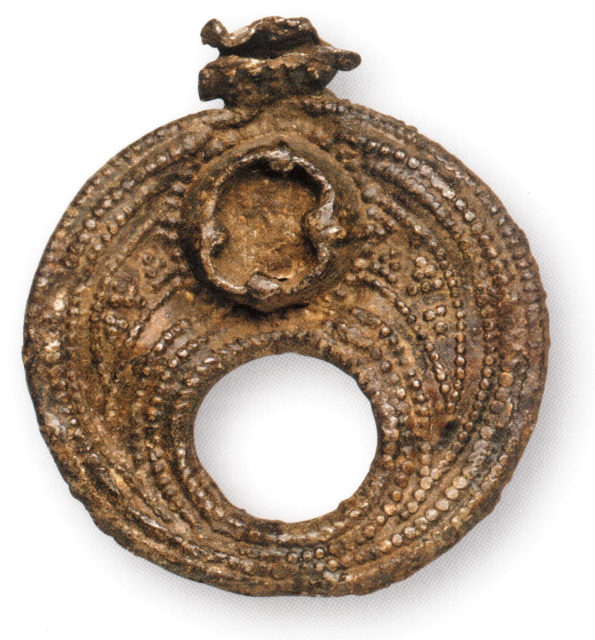
Products of Russian blacksmiths were also valued in other countries. It is no coincidence that in the Baltic States, the Czech Republic, and the Balkans, ordinary objects are found, such as padlocks and keys made in Russia. The lock was made like this: a spring was inserted into the cylindrical case, which was one or two thin plates soldered onto the rod. The second end of the spring rod was fixed in a small cylinder connected to the first plate. At the bottom of the large cylinder was a key hole. What could be easier? But it is enough to change the thickness or number of plates in the spring - and another key is needed. That is, each lock and key to it were single. It is not surprising that locksmiths emerged early as a separate specialty, because the lock had from 35 to 42 parts assembled by soldering. The body of the castle, as a rule, was decorated with overlaid parts made of copper alloys or completely covered with non-ferrous metal.
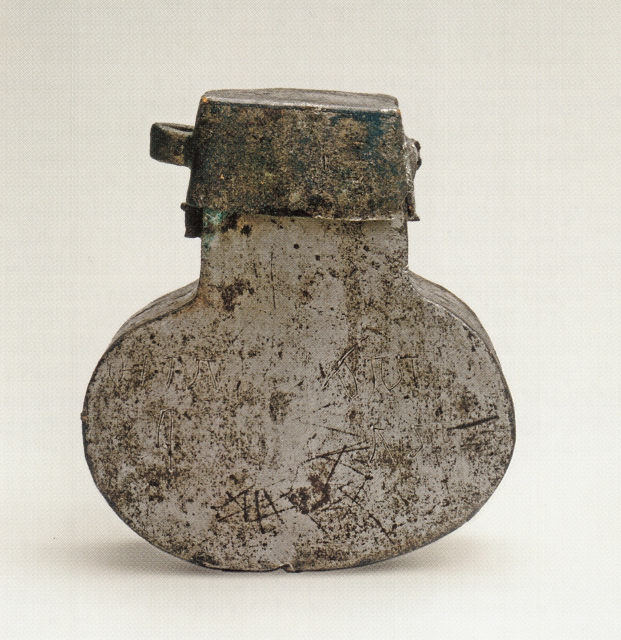
Non-ferrous metals were used quite widely, and their processing methods were common: casting, forging, stamping, embossing, embossing. Raw materials were either brought, often from afar (Scandinavia, Hungary), or often smelted from old or broken things. Craftsmen's products made of non-ferrous metals were in great demand: a variety of women's jewelry, costume details and accessories, religious objects and church utensils, weight weights, flails and maces for soldiers. By the middle of the XII century. along with other technologies, they invented casting in imitation forms, which made it possible to reproduce complex jewelry from a cheap lead-tin alloy. Such "splash" casting - the metal poured into the mold solidified on its walls with a thin layer, and the excess splashed out - made it possible to obtain hollow light decorations, and rare metal was saved.
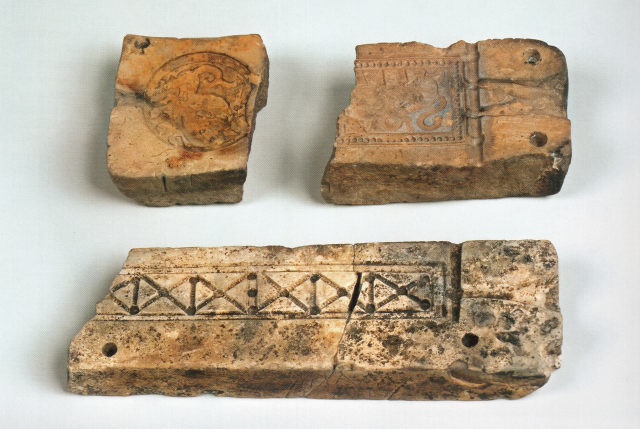
"Copper smiths" were made in the XII-XIII centuries. decorations for both townspeople and residents of the district. They also made cult objects: cross-vests and encolpions, church decoration and utensils. One of the most impressive examples of such products are the arches from the church of the Vshchizh settlement (in the 12th-13th centuries it was a real city, its ruins were discovered at the end of the 19th century on the territory of the Bryansk region). They are cast using the wax model technique, that is, with the loss of shape. The openwork belt ornament is divided by ovals with images of heraldic birds. These arches are valuable not only for the elegance of execution, but above all for the master's signature, which was added during casting: "Lord, help your servant Konstantin." This is the rarest case, since almost all medieval art is anonymous. Among several dozens of epigraphic monuments, a few names of masters were found. Most often they are found on church objects. The exception was a jeweler named Maxim, who marked his casting molds, one of which was found in Kiev, and the second in the center of metallurgists - Serensk (the city was burned down during the Mongol-Tatar invasion; now the village of the same name in the Kaluga region stands in its place).
We bring to your attention another chapter from the book of the famous Russian scientist Boris Alexandrovich Kolchin"Technology of metal processing in Ancient Russia" (M., 1953). The tool of the ancient Russian blacksmith is widely represented among the ancient Russian archaeological materials. This makes it possible to describe each type of instrument separately.
Anvil - a solid support on which the product was forged. Old Russian written sources of the XI century. the anvil is mentioned repeatedly. In the texts, it has quite modern terminology:
“Sneak hard iron... strike and anvil” (the master forges hard iron... with a hammer on an anvil). Written sources of the XII century. call the anvil "hard".
Anvils have been found in settlements and in burials. Most of the anvils that have come down to us are small anvils of a jeweler and a locksmith. The actual blacksmith's anvils were massive supports weighing more than 8 kg with a rectangular working surface and a process on one side in the form of one or two horns.
The height of the anvil from the ancient Russian settlement Knyazhaya Gora was 25 cm, the length of its working surface was 18 cm and the width was 11 cm. She weighed about 13 kg. The anvil of the Raykovets settlement had one horn. Its height was 24 cm, the working surface was wedge-shaped and turned into a round horn on one side. Anvil width 10 cm, length 27 cm, weight about 15 kg.
Old Russian blacksmith anvils had a size and mass sufficient to forge a large forging (sword, scythe, plowshare) on them, and a device in the form of a horn for figured work, and differed from modern ones only in their lower wedge-shaped part, with which they were driven into a massive wooden block. The transition to a flat base of the anvil occurred later, in the 16th–17th centuries.
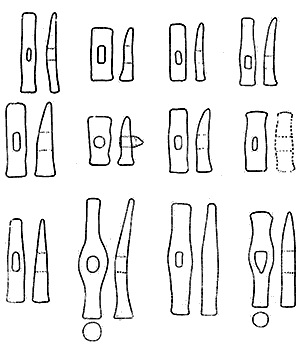
The hammer in ancient Russian written sources had several vowels: “omlat”, “mlat”, “hammer” and, finally, “kyi”. It consisted of
metal shock part - head and wooden handle. The impact planes of the hammer head, depending on its purpose, had different shapes. For forging drawing work, the shock plane was given a rib-like, rounded shape (the modern name is the back-sharp). The curvature of the shape facilitated the flow of the metal and prevented the cuts of individual fibers during strong impacts. For forging flattening work, the striker was given a square or rectangular slightly convex or flat surface. The modern name is the striker.
Among the archaeological finds, the most common type of hammer is the universal hammer. At one end of the head of such a hammer, a striker is made, and at the other, a back-sharp. But there are hammers with two strikers. By weight, hammers are divided into handbrakes weighing up to 1.0 kg and combat hammers-sledgehammers weighing more than 1.5 kg. In the handicraft industry of the XVIII-XX centuries. blacksmith hammers made of iron with welded steel heads. Obviously, the ancient Russian blacksmiths also welded their hammers.
The shape of the wooden handles, due to the poor preservation of the wood, can only be judged by the holes for the handle in the hammer head, which were oval and round. The length of the handles ranged from 350 to 700 mm. To harden the nozzle of the hammer head, an iron wedge was driven into the end of the handle.

Three hammer-sledgehammers are known among the ancient Russian archaeological material. They are massive and heavy. The head length, for example, of a hammer from the Knyazhaya Gora settlement is 125 mm; Their weight ranges from 0.2 to 1.0 kg. The heads vary in size from small, 80 mm long, to long, strongly elongated, more than 200 mm in size. Hand hammers have been found in many ancient Russian settlements of the 10th, 11th, 12th and early 13th centuries. Already in the X century. Hammers-sledgehammers and hammers-handbrakes had a constructive form that maximally met the functional conditions of this tool, and have retained it to this day.
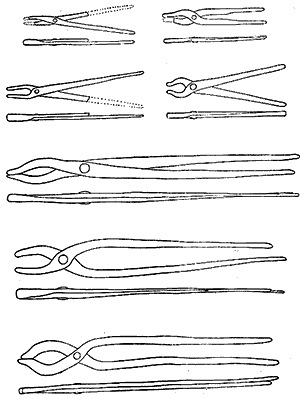
The tongs were used to extract the forging from the hearth, to hold and turn it on the anvil. In ancient Russia, ticks had the same name as they do today: “Spadosha a tick from heaven, starting to forge a weapon.” Sometimes they were called "withdrawn."
Ticks were made exclusively articulated, from two halves. Tweezers were used only by a jeweler. According to the design and size, the pliers are divided into blacksmith pliers and screaming pliers.
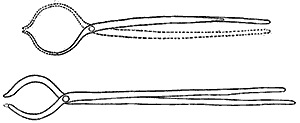
The blacksmith worked with the former, the latter was used by the metallurgist for removing the bloom from the raw-blood furnace or for holding the bloom during forging. Both types of ticks are represented among the archaeological finds in the settlements and in the burials.
According to the shape and size, it can be divided into a group of large coarse pliers for large forgings and a group of small one-handed pliers with well-fitted lips for medium and small products. The lips of both types of flares on all specimens lie one on top of the other across the entire breadth of the cheek. This is achieved on large pincers by bending the lip after the hinge towards the second half and slightly flattening the end of the cheek. On small flares, tight overlap occurs due to a small thickened knee on the cheek after the hinge. The length of large mites fluctuates around 40–45 cm, sometimes reaching 51.5 cm. Small mites reach a length of 14.5–20 cm. All pliers were made from ordinary bloomery iron. Blacksmith tongs, like hammers, already in the X century. had a rationally designed shape and were made in various sizes depending on the size of the forging. This design of ticks has come down to our days.
Scream ticks. All specimens are of a large size with characteristic large rounded lips for grasping the jaws and long handles. Only four specimens of such ticks are known - three from Novgorod and one from the Raykovets settlement. Novgorod ticks were 77 cm long; round lips for the girth of large kritz were 16.5 cm long.
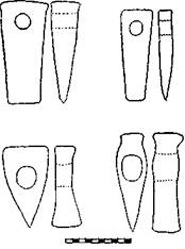
Chisel. There are two types of chisels - for hot cutting, which was performed by a blacksmith, and for cold cutting, which was made by a locksmith and jeweler. Both types of chisels are presented in the archaeological material. Blacksmith chisels for hot cutting have always had big size, massive blades (up to 50 mm and with a sharpening angle of 50–70 °) and a handle. Chisels for cold cutting differed from blacksmith chisels, firstly, in their small size and the absence of holes for handles, and, secondly, in the increased hardness of the blade. In the archaeological material, metalwork chisels are more widely represented than blacksmith's chisels. They were found in cemeteries and burial mounds, in urban and gorodishche layers. The length of these chisels does not exceed 75 mm, the width of their blades is varied and ranges from 8 to 33 mm.
A metallographic study of several ancient Russian metalwork chisels revealed a very interesting technology for their manufacture. The chisels were made of all-steel or iron with welded blades. The blades of the chisels were exposed heat treatment- hardening. In the chisels we studied, the blades were hardened for martensite. The microhardness of the tip varied from 724 to 919 Vickers units. This is a very high hardness. With a similar chisel, a locksmith could very easily cut any iron and steel product.
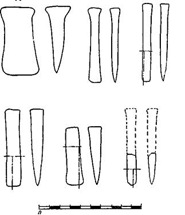
Old Russian locksmiths and blacksmiths, in addition to the described chisels, used another type of tool for cutting metal. This is the so-called undercut or lower chisel.
A copy of such a chisel was found at the Raykovets settlement. It consists of a wedge-chisel, passing at the other end into a pyramidal point, with which the chisel was driven into a massive wooden stand. The total length of such chisels reached 75 mm, the length of the chisel wedge was 38 mm, the blade width was 2.2 mm, and the blade angle was 30°. When cutting the product, it was placed on the blade of a chisel and hit with a hammer. Such chisels were one of the main tools of the carpenter. On them, during the mass production of nails, the nailer cut off the body of the elongated rod. Similar chisels were also used by jewelers for cutting wire.
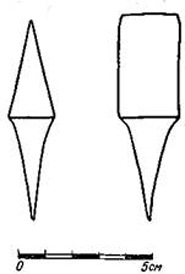
Beards. A large number of ancient Russian iron products has on its body through holes different sizes and shapes, which could only be pierced with a special tool called a punch, or a beard. The pointed end of the beard was made of steel and heat-treated. When working with a beard under the product, a stand with a hole of the appropriate size was placed in the place where it was necessary to punch a hole. Technological analysis of ancient Russian things undoubtedly speaks of a wide application Old Russian blacksmiths similar tool.
Crimps. Technological study of figured blacksmith products reveals the presence of another type blacksmith tool, which is not yet available among the archaeological material, - figured swage stamps and linings. A number of blacksmith products, such as arrows, have thin figured rims near the handle, which can be made only by pressure with a figured swage stamp. Ryazan scales, curly buckles, belt sets, brooches, pins, plaques, pendants, iron ornaments, harnesses, spears, arrows, curly bits, weights, etc.
The technology of working with a stamp-swaging was as follows. With one-sided profiling, a piece of heated iron of a certain size was placed on the anvil. On it, in the required place, a swage stamp was applied, on which a drawing of the product was applied in a negative image, and then hit with a hammer. If the object was profiled from all sides, then a curly lining was also placed under the swaging stamp.

Nailer. For the manufacture of nail heads and rivets, a special tool is required, in modern technology called a nail. This is a thick flat plate with one or more round or square holes, on which the heads of nails and rivets are upset and riveted. The heads of most ancient Russian nails and rivets are upset and riveted. A well-preserved nail-house was found on Knyazhaya Gora. This is a thick plate 120 mm long, 20 mm wide and 10 mm thick. It has two round holes of different diameters. At one end, the nailer plate passes into a pointed handle, on which a handle was put on to hold the nailer during operation.
Boris Kolchin
The history of blacksmithing is an integral part of metal processing. At the very beginning, cold forging appeared. For many centuries, only this method of making weapons, household utensils, and jewelry was used. It is now the jewelry industry that has nothing to do with blacksmiths, and earlier everything related to metalworking belonged to blacksmithing.
Looking at history books that tell about the development of crafts in the Iron and Bronze Ages, you can see photographs of objects made by craftsmen from different parts of the Earth. Blacksmith - this profession is covered with myths and legends. Blacksmithing developed differently in different territories. Only for many centuries the cold method of forging metal was used.
There was also such a name for the profession as "Khytrets". This epithet was brought to us by books dated 1073. By right, the blacksmithing of those times can be called cunning. The blacksmith had to distinguish metals by color, determine their strength by the shade at the break. There was something mystical in the very process of production, when a piece of metal under the influence of strong short hammer blows turned out to be an item of extraordinary beauty or a bizarre shape.
With the help of deformation of the metal, which receives additional density and strength under the influence of strong pressure, the things necessary in everyday life came out from under the hammer of a sly, writhing, iron forging, kovac, kerch, and duck. The first mention of this profession can be found in books that convey the myths of ancient Greece. Prometheus was chained to a rock with nails forged by Hephaestus.
The power of blacksmiths is sung in many literary works different eras. Blacksmiths were considered healers, healers and people capable of exorcising evil spirits. Based on such beliefs, Gogol created his blacksmith Vakula. It was rumored that Svarog himself patronizes writhing.
Places in Russia named after blacksmiths
The profession of a blacksmith requires a master of good physical fitness. It has always been so. Not every warrior would dare to measure his strength with a blacksmith. Residents of the Pskov region are still called staplers, bearing in mind that the blacksmiths of these places with bare hands horseshoes bent.
The profession of a blacksmith has had many names over the years. One of the most common gave the name to the city of Kerch. This name came from the word korchev, which means a blacksmith. Related terms of those times:
- Korchin - blacksmith;
- Crimson - forged.
There is also a place in Moscow, the name of which indicates the proximity to the blacksmith's settlement - this is the Blacksmith's Bridge. There was such a freedom in Novgorod. Mentions of large settlements of blacksmiths in cities date back to the 15th-17th centuries. It was in the cities that the development of this profession received more opportunities, thanks to the demand for forged decorations for the facades of large houses, gardens and parks. As well as in Kievan Rus, edged weapons were made in forges, which were hardened by fire.
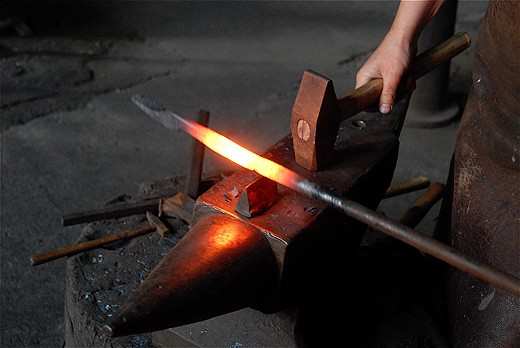
famous swords
The damask blade has been sung more than once in books and hussar songs. The classics of Russian literature often used in their works the features of swords to cut through stone. The prototype of magic swords was:
Excalibur is the sword of King Arthur, which, while defending the fortress, was stuck in a stone wall. Popular beliefs endow this sword with magical power. In Russian culture, the sword "Kladenets" serves as a similar artifact. "Durandale" - the sword of Roland and the nameless blade of the Tuscan knight Galliano Guidotti were also able to pierce the stone. These blades received the ability to cut stone thanks not so much to magical and mystical powers, but to the diligence and skill of the craftsmen who made them.
The sword of Galliano Guidotti radically changed the fate of its owner. The books tell us the story that this knight was canonized, although he was not a righteous man before meeting with the Archangel Michael. The warrior answered the proposal to go to the monastery to Michael that this would happen only after his sword had cut the stone. The sword entered the cobblestone, and so it remained there. Modern scientists have had the opportunity to examine the stone and the sword. Their conclusion confirmed that the blade pierced the stone precisely at the time described in the annals.
Already in knightly times, blacksmithing had many secrets passed down by craftsmen from generation to generation. One of them was the shape of the blank; for the above swords, a quadrangular rod served as the basis. Blades related to Japanese culture are also widely known. Their names are translated as "the sword that cuts the grass", "the sword that collects the clouds of paradise." They are distinguished by a curved shape, which gives melee weapons Japanese masters aerodynamic properties are not typical for products of European blacksmiths.
One of the famous swords on display at the Polish Museum in Poznan is the weapon of St. Peter, forged in the 1st century. The blade is famous for the fact that during the arrest of Christ before the crucifixion, Peter managed to cut off the ear of a slave. The sword was transferred to the museum by the Bishop of Jordan.
Milestones in the development of blacksmithing
Hand forging is the oldest method of metal processing, which has become the progenitor of stamping, forging, casting, pressing, rolling, drawing and sheet stamping. Archaeologists found during excavations hardware dating back to several thousand years BC. These products are made of metals found in nature. The first metal finds by archaeologists date back to the 5th-4th centuries BC. The technique of drawing in the manufacture of products from precious metals was discovered in the basins of the Tigris and Euphrates rivers. Products are made in 3 BC. Blacksmithing in Russia has a longer history. Swords, helmets, chain mail, ax grips, jewelry and other forged items date back to the 18th century. BC.
From the 10th to the 18th centuries from the birth of Christ, new methods appeared in metalworking:
- metal hardening;
- soldering with copper;
- forge welding;
- multilayer fabrication technique.
XVI century. Under Ivan the Terrible, the Russian army was equipped with forged cannons.
XVII - XVIII - the creation of state arms factories in the Urals and in Tula.
Peter I in every possible way contributes to the development of the metallurgical industry. Water engines are widely used in military factories. At the turn of the century, in 1800, for the first time at the Tula plant, the method of hot stamping of the same type of parts was tested. It was used for mass production by the blacksmith V.A. Shepherds.
At the same time, blacksmiths in Vologda specialized in the production of anchors, and in Murom they produced hardware for the construction of the fleet.
19th century Steam engines are replacing the water drive, which contributes to the development of shipbuilding and the production of artillery equipment for the fleet and army, for the production of which armor, thick plates for gun carriages, and gun barrels were needed. The weight of the falling hammer was up to 50 tons. Such hydraulic presses expanded the capabilities to forging parts of 250 tons.
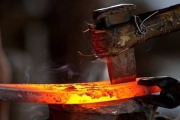
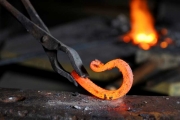
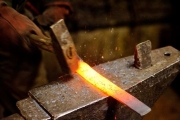
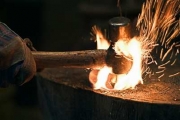
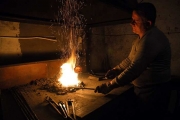
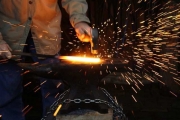
The same period includes scientific research on the deformation of metals. Armed with a microscope, P.P. Anosov began to study the structure of steels. During the study in 1841, he established the relationship between the structure and properties of metals. This made it possible to create steel with the necessary technical specifications. D.K. Chernov conducted a study of the behavior of metals during heating and cooling, which served as the discovery of structural changes. Books with the research of Chernov and Anosov still serve as a guide for metallurgists.
Introduction to blacksmith skills through exhibitions
In addition to permanent exhibitions in museums, products of decorative blacksmithing can be seen at exhibitions where weapons and weapons are not presented. Jewelry, and the work of masters to decorate everyday life. Exhibitions are not just a display of beautiful things, they are popularization, which blacksmithing needs so much. For several 10 years, this craft was practically forgotten due to the expanding opportunities in metalworking every year. But other methods are stamping, work on quantity. Only blacksmithing when working with metal will help the master to reveal himself most fully.
The history of the revival of blacksmithing began not so long ago, but the construction of private houses contributes to this. Each owner wants to allocate his home and surrounding area. Exhibitions of masters make it possible to understand how this can be done in an extraordinary way and at the same time not pretentiously. For novice blacksmiths, these exhibitions help to find their own style, to peep some of the techniques that they share from more experienced blacksmiths, holding master classes directly in the walls, where displays of finished decorative products are held.
Exhibitions blacksmith skills held in the Art Kremlin became a good start for beginners, for whom the craftsmen staged a demonstration of the possibilities of changing a piece of metal, turning into fully formed figurines for decorating their homes.
A great way to instill in beginners a love for metalworking by forging, giving the first skill lessons right at the exhibition. "Blacksmith's Talisman" is an exhibition where everyone had the opportunity to try their hand, to feel the changes in the material under their own hammer blows.
Exhibitions of blacksmith skills are becoming a good tradition. In September 2015, the Forge of Happiness exhibition was opened for the 4th time as part of the Indian Summer festival. Master classes were also held here.
Numerous books that tell about various technologies of cold and hot forging, casting, forge welding, and technologies for creating decorative elements will help beginners to master all the intricacies of the science of metal processing.
Books can tell a lot, but still blacksmithing, as in junk, is passed from hand to hand by the master to the student.
If you find an error, please highlight a piece of text and click Ctrl+Enter.











How to understand: will the kitten be fluffy?
What kind of light alcohol can be drunk for pregnant women: the consequences of drinking
Why do the legs swell in the ankles and ankles of the feet in pregnant women: causes and methods of treatment
The wedding of Prince Harry and Meghan Markle: scandalous and secret details of the marriage (photo) The future marriage of Prince Harry year NTV
How to close white plums for the winter